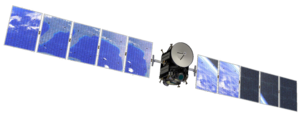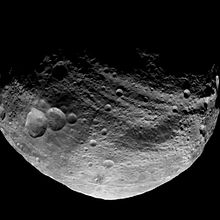
Back Dawn-ruimtetuig Afrikaans داون (مسبار فضائي) Arabic Дон (космически апарат) Bulgarian डॉन अंतरिक्षयान Bihari Dawn (letjelica) BS Dawn Catalan Dawn (sonda) Czech Dawn (rumsonde) Danish Dawn (Raumsonde) German Διαστημική αποστολή Dawn Greek
 Illustration of the Dawn spacecraft | |||||||||
| Mission type | Multi-target orbiter | ||||||||
|---|---|---|---|---|---|---|---|---|---|
| Operator | NASA / JPL | ||||||||
| COSPAR ID | 2007-043A | ||||||||
| SATCAT no. | 32249 | ||||||||
| Website | http://dawn.jpl.nasa.gov/ | ||||||||
| Mission duration | Planned: 9 years Final: 11 years, 1 month, 5 days | ||||||||
| Spacecraft properties | |||||||||
| Manufacturer | Orbital Sciences · JPL · UCLA | ||||||||
| Launch mass | 1,217.7 kg (2,684.6 lb)[1] | ||||||||
| Dry mass | 747.1 kg (1,647.1 lb)[1] | ||||||||
| Dimensions | 1.64 × 19.7 × 1.77 m (5.4 × 65 × 5.8 ft)[1] | ||||||||
| Power | 10,000 watts at 1 AU[1] 1,300 watts at 3 AU | ||||||||
| Start of mission | |||||||||
| Launch date | September 27, 2007, 11:34 UTC[2] | ||||||||
| Rocket | Delta II 7925H | ||||||||
| Launch site | Cape Canaveral SLC-17B | ||||||||
| Contractor | United Launch Alliance | ||||||||
| End of mission | |||||||||
| Disposal | Uncontrolled/stable orbit | ||||||||
| Last contact | 30 October 2018 | ||||||||
| Flyby of Mars | |||||||||
| Closest approach | February 18, 2009, 00:27:58 UTC[2] | ||||||||
| Distance | 542 km (337 mi)[2] | ||||||||
| 4 Vesta orbiter | |||||||||
| Orbital insertion | July 16, 2011, 04:47 UTC[3] | ||||||||
| Orbital departure | September 5, 2012, 06:26 UTC[2] | ||||||||
| 1 Ceres orbiter | |||||||||
| Orbital insertion | March 6, 2015, 12:29 UTC[2] | ||||||||
| |||||||||
 Dawn mission patch | |||||||||
Dawn is an unmanned NASA space probe. It has orbited and studied the asteroid Vesta, and it is currently orbiting the dwarf planet Ceres. Both Vesta and Ceres are in the asteroid belt. Dawn is the first spacecraft to visit Ceres and the first to visit Vesta.[4] It also is the first spacecraft to orbit two extraterrestrial bodies.[4]
Dawn was launched on September 27, 2007[5][6][7] at Cape Canaveral Air Force Station aboard a Delta 7925-H rocket.[6][7] It then travelled to Mars for a gravity assist, making its closest approach to Mars in February 2009.[5]

Next, Dawn set off for Vesta.[5] It went into orbit in July, 2011.[5] On September 5, 2012, Dawn left Vesta and headed for Ceres.[4] It began to orbit Ceres on March 6, 2015.[4][8]
- ↑ 1.0 1.1 1.2 1.3 "Dawn at Ceres" (PDF) (Press kit). NASA / Jet Propulsion Laboratory. March 2015.
- ↑ 2.0 2.1 2.2 2.3 2.4 "Dawn". National Space Science Data Center. NASA. Retrieved November 20, 2016.
- ↑ Brown, Dwayne C.; Vega, Priscilla (August 1, 2011). "NASA's Dawn Spacecraft Begins Science Orbits of Vesta". NASA. Archived from the original on February 2, 2019. Retrieved August 6, 2011.
- ↑ 4.0 4.1 4.2 4.3 "Dawn at Ceres" (PDF). NASA. Retrieved 2015-03-07.
- ↑ 5.0 5.1 5.2 5.3 Schilling, Govert (July 2011), "Solar System sleuth", BBC Sky at Night Magazine, no. 74, pp. 38–43
- ↑ 6.0 6.1 "Dawn Launch". NASA. Archived from the original on 2017-06-24. Retrieved 2011-08-16.
- ↑ 7.0 7.1 "Week in Photos: Dawn Lifts Off, Pike Poisoned, More". National Geographic. Retrieved 2011-08-16.
- ↑ "NASA Spacecraft Becomes First to Orbit a Dwarf Planet". NASA. 6 March 2015. Retrieved 2015-03-07.